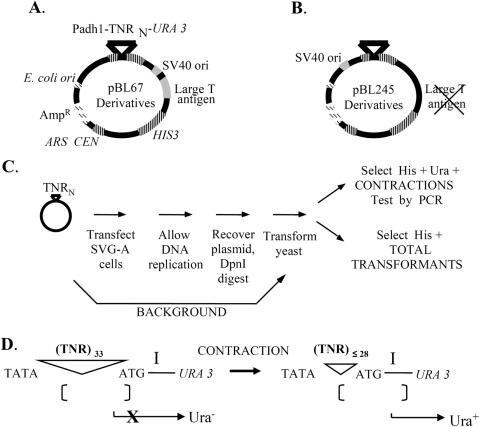Figure 1.
Shuttle vector plasmids and assay outline. Details are provided in Materials and Methods. (A) The shuttle vector pBL67 contains several important genetic elements enabling analysis of TNR instability in cultured cells. Genetic elements tinted gray, such as the SV40 origin of replication, drive plasmid replication in SVG-A cells. A striped-pattern indicates yeast genetic elements for determination of contraction frequency by selection in Saccharomyces cerevisiae. Dashed bars indicate Escherichia coli elements that enable replication and large-scale preparation of plasmid by plasmid maxi-kit (Qiagen Inc). (B) The vector pBL245 follows the same pattern scheme, the only difference between the two vectors being the absence of the large T antigen and the relocation of the SV40 ori to the opposite side of the repeat tract. (C) Each TNR-containing vector was transfected into SVG-A cells, the cells were cultured for 2–3 days, then the plasmid DNA was isolated and transformed into yeast for analysis. Contraction frequency was calculated by dividing the number of yeast colonies with a contraction by the total number of transformants. Background contraction frequencies were measured as described in Materials and Methods. (D) The selection for contractions in yeast is based on spacing sensitivity of the Schizosaccharomyces pombe adh1 promoter to the distance between the TATA box and the preferred transcription initiation site, labeled ‘I’. Starting TNR lengths of 33 inhibit expression of the URA3 reporter gene and yield a Ura− phenotype (36). TNR contractions that remove at least five repeats restore promoter activity and result in a Ura+ phenotype.

